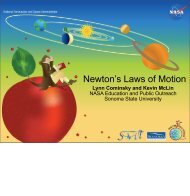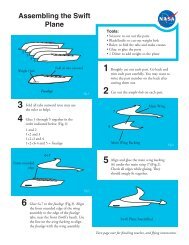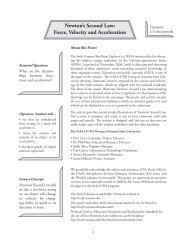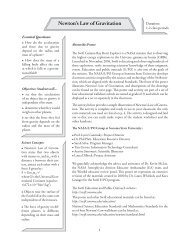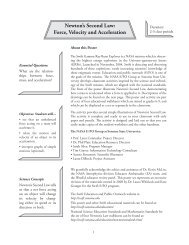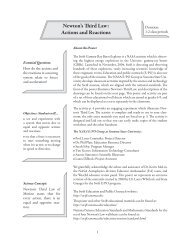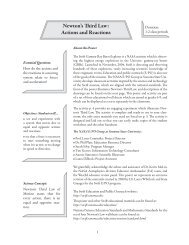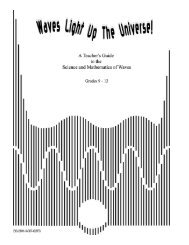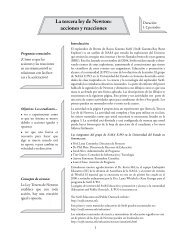Newton's Law of Gravitation - Swift - Sonoma State University
Newton's Law of Gravitation - Swift - Sonoma State University
Newton's Law of Gravitation - Swift - Sonoma State University
Create successful ePaper yourself
Turn your PDF publications into a flip-book with our unique Google optimized e-Paper software.
Newton’s <strong>Law</strong> <strong>of</strong> <strong>Gravitation</strong><br />
Duration:<br />
1-2 class periods<br />
Essential Questions:<br />
• How do the acceleration<br />
and force due to gravity<br />
depend on the radius and<br />
mass <strong>of</strong> a planet?<br />
• How does the mass <strong>of</strong> a<br />
falling body affect the rate<br />
at which it falls in a gravitational<br />
field?<br />
Objectives: Students will…<br />
• see that the acceleration<br />
<strong>of</strong> an object due to gravity is<br />
independent <strong>of</strong> its mass.<br />
• determine what they would<br />
weigh on other planets.<br />
• see that the force they feel<br />
from gravity depends on the<br />
radius and the mass <strong>of</strong> the<br />
planet.<br />
Science Concepts:<br />
• Newton’s <strong>Law</strong> <strong>of</strong> <strong>Gravitation</strong><br />
states that two objects<br />
with masses m 1<br />
and m 2<br />
, with a<br />
distance r between their centers,<br />
attract each other with a<br />
force F given by:<br />
F = Gm 1<br />
m 2<br />
/r 2<br />
where G is the Universal <strong>Gravitation</strong>al<br />
Constant (equal to:<br />
6.672 x 10 -11 Nm 2 /kg 2 ).<br />
• Objects near the surface <strong>of</strong><br />
the Earth fall at the same rate<br />
independent <strong>of</strong> their masses.<br />
• The force <strong>of</strong> gravity on different<br />
planets is different,<br />
depending on their mass and<br />
radius.<br />
About this Poster<br />
The <strong>Swift</strong> Gamma-Ray Burst Explorer is a NASA mission that is observing<br />
the highest energy explosions in the Universe: gamma-ray bursts (GRBs).<br />
Launched in November, 2004, <strong>Swift</strong> is detecting and observing hundreds <strong>of</strong><br />
these explosions, vastly increasing scientists’ knowledge <strong>of</strong> these enigmatic<br />
events. Education and public outreach (E/PO) is also one <strong>of</strong> the goals <strong>of</strong><br />
the mission. The NASA E/PO Group at <strong>Sonoma</strong> <strong>State</strong> <strong>University</strong> develops<br />
classroom activities inspired by the science and technology <strong>of</strong> the <strong>Swift</strong> mission,<br />
which are aligned with the national Standards. The front <strong>of</strong> the poster<br />
illustrates Newton’s <strong>Law</strong> <strong>of</strong> <strong>Gravitation</strong>, and descriptions <strong>of</strong> the drawings<br />
can be found on the next page. This poster and activity are part <strong>of</strong> a set <strong>of</strong><br />
four educational wallsheets which are aimed at grades 6-9, and which can be<br />
displayed as a set or separately in the classroom.<br />
The activity below provides a simple illustration <strong>of</strong> Newton’s <strong>Law</strong> <strong>of</strong> <strong>Gravitation</strong>.<br />
The activity is complete and ready to use in your classroom; the only<br />
extra materials you need are listed on p. 4. The activity is designed and laid<br />
out so that you can easily make copies <strong>of</strong> the student worksheet and the<br />
other handouts.<br />
The NASA E/PO Group at <strong>Sonoma</strong> <strong>State</strong> <strong>University</strong>:<br />
• Pr<strong>of</strong>. Lynn Cominsky: Project Director<br />
• Dr. Phil Plait: Education Resource Director<br />
• Sarah Silva: Program Manager<br />
• Tim Graves: Information Technology Consultant<br />
• Aurore Simonnet: Scientific Illustrator<br />
• Laura Dilbeck: Project Assistant<br />
We gratefully acknowledge the advice and assistance <strong>of</strong> Dr. Kevin McLin,<br />
the NASA Astrophysics division Educator Ambassador (EA) team, and<br />
the WestEd educator review panel. This poster set represents an extensive<br />
revision <strong>of</strong> the materials created in 2000 by Dr. Laura Whitlock and Kara<br />
Granger for the <strong>Swift</strong> E/PO program.<br />
The <strong>Swift</strong> Education and Public Outreach website:<br />
http://swift.sonoma.edu.<br />
This poster and other <strong>Swift</strong> educational materials can be found at:<br />
http://swift.sonoma.edu/education/<br />
National Science Education Standards and Mathematics Standards for the<br />
set <strong>of</strong> four Newton’s <strong>Law</strong> wallsheets can be found at:<br />
http://swift.sonoma.edu/education/newton/standards.html<br />
1
Description <strong>of</strong> the Front <strong>of</strong> the Poster:<br />
Solar system: All the planets in the solar system orbit the Sun due to its gravity. The inner planets are closer to the<br />
Sun and feel more gravity, so as a result they move faster.<br />
Astronaut: Gravity goes on forever; an astronaut in orbit is accelerated by Earth’s gravity. But without the balancing<br />
upward force from the ground, she falls freely. Some people call this “weightlessness”, but that’s not really true.<br />
“Free fall” is a better term.<br />
Newton: Isaac Newton was the person who realized that all massive objects in the Universe apply the force <strong>of</strong> gravity<br />
to all other massive objects. An apple didn’t really fall on his head, but he did realize that the force causing an<br />
apple to fall is the same as the force causing the Moon to orbit the Earth – the Earth’s gravity.<br />
Girl falling: While falling, a girl feels a brief period <strong>of</strong> “free fall” while she is in the air because the Earth’s gravity<br />
is not balanced by any upwards force. The gravity due to the girl’s mass applies the same force on the Earth as the<br />
Earth’s gravity does on the girl, but because the Earth has so much more mass it does not accelerate very much at<br />
all, while the girl accelerates rapidly.<br />
Bike: Bicyclists climbing a hill – or speeding down one – are certainly aware <strong>of</strong> gravity!<br />
<strong>Swift</strong> orbiting Earth: The effect <strong>of</strong> <strong>Swift</strong>’s horizontal velocity (from its launch rocket) exactly cancels the downward<br />
velocity gained from the acceleration due to Earth’s gravity. This gives <strong>Swift</strong> its circular path around the Earth. See<br />
“Newton’s law <strong>of</strong> <strong>Gravitation</strong> and the <strong>Swift</strong> Satellite” below.<br />
Background Information for Teachers:<br />
Newton’s <strong>Law</strong>s <strong>of</strong> Motion and the <strong>Law</strong> <strong>of</strong> <strong>Gravitation</strong>.<br />
It is well-known today that the force <strong>of</strong> gravity an object<br />
feels depends on a relatively simple relationship:<br />
F=<br />
GmM<br />
r 2<br />
The derivation <strong>of</strong> Newton’s <strong>Law</strong> <strong>of</strong> <strong>Gravitation</strong><br />
is beyond the scope <strong>of</strong> this activity. However, if<br />
you want to see it, it can be found on the <strong>Swift</strong><br />
site: http://swift.sonoma.edu/education/newton/<br />
newton_4/derivation.html<br />
where F is the force <strong>of</strong> gravity, M is the mass <strong>of</strong> one object, m is the mass <strong>of</strong> a second object, r is the distance between<br />
them, and G=6.672 x 10 -11 Nm 2 /kg 2 is a constant called Newton’s Universal <strong>Gravitation</strong>al Constant.<br />
This relationship governs the motion <strong>of</strong> the planets in their orbits, guides spacecraft to their destinations, and even<br />
keeps our feet firmly on the ground. Sir Isaac Newton derived this equation in the 17 th century but it is still useful<br />
today.<br />
When you teach students science, they love to ask, “How does this affect me?” For once, you can answer this honestly:<br />
this directly affects them. It affects everything! In fact, we can use Newton’s equation to figure out just how<br />
hard the Earth is pulling us.<br />
GmM<br />
F=<br />
Look again at the equation.<br />
r 2<br />
We know that F = ma from Newton’s Second <strong>Law</strong> <strong>of</strong> Motion. We can set that equal to the equation above, and solve<br />
for a, the acceleration due to Earth’s gravity:<br />
a = G M E<br />
/ R E<br />
2<br />
where M E<br />
is the mass <strong>of</strong> the Earth and R E<br />
is its radius. We know the values <strong>of</strong> all these numbers:<br />
G = 6.672 x 10 -11 N m 2 /kg 2<br />
M E<br />
= 5.96 x 10 24 kg<br />
R E<br />
= 6375 km<br />
2
Substituting those into the equation above, we see that the acceleration due to gravity for any object on the<br />
Earth’s surface (usually called g or “little g”) is 9.8 m/sec 2 . In other words, an object dropped near the Earth’s<br />
surface will accelerate 9.8 m/sec for every second it falls: it will move at a velocity <strong>of</strong> 9.8 m/s after the first<br />
second, 2 x 9.8m/sec = 19.6 m/sec the next, 3 x 9.8m/sec = 29.4 m/sec the next, and so on.<br />
This equation has a very important implication: the mass <strong>of</strong> the object falling doesn’t matter! A grape and a<br />
grand piano will both fall at the same acceleration, and therefore the same velocity (if they both drop from<br />
the same height). This is counter-intuitive to most people, including, most likely, your students. Our intuition<br />
tells us that more massive objects fall faster, but that is not correct.<br />
Students may be confused by this because they know that more massive objects weigh more. While this is<br />
true, it is important to distinguish between weight and mass. Mass is intrinsic to matter, but weight is the<br />
force <strong>of</strong> gravity on that mass. Remember, F=ma. The acceleration due to gravity does not depend on the<br />
mass <strong>of</strong> the object falling, but the force it feels, and thus the object’s weight, does.<br />
This tells us two things. One is that the speed at which an object falls does not depend on its mass. The<br />
second is that if the acceleration due to gravity were different (say, on another planet) you’d weigh a different<br />
amount. These two concepts are the basis <strong>of</strong> the classroom activities.<br />
Additional Background Information for Teachers:<br />
Sir Isaac Newton (1642-1727) established the scientific laws that govern 99% or more <strong>of</strong> our everyday experiences.<br />
He also explained our relationship to the Universe through his <strong>Law</strong>s <strong>of</strong> Motion and his Universal<br />
<strong>Law</strong> <strong>of</strong> <strong>Gravitation</strong>. These are considered by many to be the most important laws in all physical science.<br />
Newton was the first to see that such apparently diverse phenomena as an apple falling from a tree, the<br />
Moon orbiting the Earth, and the planets orbiting the Sun operate by the same principle: force equals mass<br />
multiplied by acceleration, or F=ma.<br />
Our everyday lives are influenced by different forces: for example, the Earth exerts a force on us that we call<br />
gravity. We feel the force required to lift an object from the floor to a table. But how exactly does Newton’s<br />
Second <strong>Law</strong> <strong>of</strong> Motion relate to gravity? To understand Newton’s <strong>Law</strong> <strong>of</strong> <strong>Gravitation</strong>, you must first understand<br />
the nature <strong>of</strong> force and acceleration when applied to circular motion, rather than motion in a straight<br />
line.<br />
Newton’s First <strong>Law</strong> <strong>of</strong> Motion tells us that, without the influence <strong>of</strong> an unbalanced force, an object will<br />
travel in a straight line forever. This means that an object traveling in a circular path must be influenced by<br />
an unbalanced force. The circulating object has a velocity that is constantly changing, not because its speed<br />
is changing, but because its direction is changing. A change in either the magnitude (amount) or the direction<br />
<strong>of</strong> the velocity is called acceleration. Newton’s Second <strong>Law</strong> explains it this way: A net force changes the<br />
velocity <strong>of</strong> an object by changing either its speed or its direction (or both.)<br />
Therefore, an object moving in a circle is undergoing acceleration. The direction <strong>of</strong> the acceleration is toward<br />
the center <strong>of</strong> the circle. The magnitude <strong>of</strong> the acceleration is a= v 2 /r, where v is the constant speed along the<br />
circular path and r is the radius <strong>of</strong> the circular path. This acceleration is called centripetal (literally, “centerseeking”)<br />
acceleration. The force needed to produce the centripetal acceleration is called the centripetal<br />
force, F cent<br />
= ma cent<br />
, according to Newton’s Second <strong>Law</strong>. So therefore the centripetal force can be written as<br />
F cent<br />
= ma cent<br />
= mv 2 /r<br />
3
Majestic examples <strong>of</strong> circular motion can be found throughout our Universe: Planets orbit around the Sun in<br />
nearly circular paths; moons orbit around their planets in nearly circular paths; and man-made satellites (such as<br />
<strong>Swift</strong>) can orbit the Earth in nearly circular paths.<br />
Pre-Activity Reading:<br />
Newton’s <strong>Law</strong> <strong>of</strong> <strong>Gravitation</strong> and the <strong>Swift</strong> Satellite<br />
In our previous Newton’s <strong>Law</strong> posters, we examined what happened when <strong>Swift</strong> was launched in the rocket and<br />
what happens as the rocket burns its fuel. We also studied the forces acting on <strong>Swift</strong> as it went into orbit. In this<br />
final poster we will study the relationship between the gravitational force on <strong>Swift</strong> and its acceleration and velocity.<br />
Recall that as <strong>Swift</strong> enters its orbit, it has velocity that is purely “horizontal” – that is, it is moving parallel to the<br />
curved surface <strong>of</strong> the Earth at each point. However, the force <strong>of</strong> the Earth’s gravity on <strong>Swift</strong> is “vertical” – pointed<br />
towards the center <strong>of</strong> the Earth. Why then does <strong>Swift</strong> not fall to Earth immediately? The answer is that <strong>Swift</strong><br />
moves horizontally at just the right rate so that as it falls vertically, its motion creates a circular path around the<br />
Earth. This balance between “horizontal” and “vertical” motion is what is meant by “being in orbit.” <strong>Swift</strong> will<br />
be able to stay in orbit for many years, as long as its horizontal velocity is maintained at a high enough rate. The<br />
special relationship between the horizontal velocity and the gravitational acceleration for any body that is orbiting<br />
another more massive body was worked out by Johannes Kepler years before Sir Isaac Newton figured out the<br />
<strong>Law</strong> <strong>of</strong> Universal <strong>Gravitation</strong>.<br />
V hor<br />
Eventually, the cumulative effect <strong>of</strong> the small number <strong>of</strong> atmospheric<br />
molecules hitting <strong>Swift</strong> in its orbit 600 km above<br />
Earth will cause the “horizontal” motion <strong>of</strong> the satellite<br />
to slow down; its horizontal motion will no<br />
V hor<br />
longer be able to completely counteract its vertical<br />
motion. When this happens, <strong>Swift</strong>’s orbit<br />
will start to “decay.” As <strong>Swift</strong> spirals in closer to<br />
the Earth there will be even more atmospheric<br />
drag, which will cause <strong>Swift</strong>’s orbit to decay<br />
increasingly faster. <strong>Swift</strong> will end its life plunging<br />
in through the Earth’s atmosphere, probably<br />
sometime around 2014.<br />
a cent<br />
a a<br />
cent<br />
cent<br />
V hor<br />
a cent V hor<br />
V hor<br />
V hor<br />
The relationship between the velocity and acceleration<br />
a cent<br />
<strong>of</strong><br />
<strong>Swift</strong> in its<br />
orbit is shown<br />
to the left and<br />
also on the front <strong>of</strong><br />
the poster (not to scale).<br />
Procedure for In Class Activities: Newton’s <strong>Law</strong> <strong>of</strong> <strong>Gravitation</strong><br />
In these two activities, your students will investigate Newton’s <strong>Law</strong> <strong>of</strong> <strong>Gravitation</strong>.<br />
Materials:<br />
• Several objects <strong>of</strong> different<br />
masses and sizes, such as pencils,<br />
crumpled up aluminum foil,<br />
coins, fishing weights, etc. Make<br />
sure they are not breakable!<br />
• Calculator<br />
In the first activity, you can divide them into teams to experimen-<br />
tally investigate the fact that the acceleration <strong>of</strong> an object due to gravity is<br />
independent <strong>of</strong> its mass. In the second activity (for advanced students),<br />
they can work individually or in pairs to calculate how their weight would change on other bodies in the solar<br />
system, and to see that the force due to gravity, and hence their weight, depends on the radius and mass <strong>of</strong> the<br />
planet.<br />
a cent<br />
4
Part A: The Fall <strong>of</strong> Man<br />
Your students will be dropping various objects to the floor to see if they fall<br />
at different rates. Go over the background material to the level you think is<br />
appropriate for your class, but do not go over the concept that acceleration<br />
is independent <strong>of</strong> the mass <strong>of</strong> the falling object! They will find this out for<br />
themselves in the first part <strong>of</strong> the activity. When you give them materials<br />
to test, make sure they have different sizes, masses, and densities. Make sure<br />
they are not breakable! Also, make sure they won’t be affected too much by<br />
air resistance; a balloon or a piece <strong>of</strong> paper won’t work (although crumpled<br />
paper will if it is wadded up tightly).<br />
After this activity, discuss the results with the students. Most likely, they<br />
will have predicted that the heavier object will hit first and found that this<br />
is not true; the two objects fell together at the same rate. Explain to them<br />
that this is because the acceleration due to gravity is independent <strong>of</strong> mass.<br />
Some students may have a hard time internalizing this. They may even disagree<br />
with the results. If that happens, demonstrate the activity for them<br />
again from a higher elevation (standing on a chair, for example), using very<br />
different mass objects (like a pencil and a heavy weight).<br />
Hint:<br />
Students may get stuck on Question<br />
3, where they try to think <strong>of</strong><br />
things that may have thrown <strong>of</strong>f<br />
their timing. The two largest factors<br />
in this are human reaction<br />
time and air resistance. If they get<br />
stuck, ask them to drop a pencil<br />
and an unfolded sheet <strong>of</strong> paper.<br />
Then have them repeat the experiment,<br />
but this time with a pencil<br />
and a tightly wadded piece <strong>of</strong><br />
paper. Ask them why the wadded<br />
paper fell faster, and they should<br />
see that air resistance slowed the<br />
paper the first time.<br />
Part B: The Gravity <strong>of</strong> the Situation (Advanced Students)<br />
Before doing Part B, remind them <strong>of</strong> the difference between acceleration and force. Go over Newton’ s law <strong>of</strong><br />
gravitation, and stress the idea that the acceleration due to gravity on a planet’s surface depends on the planet’s size<br />
and mass, and that this means that they would have different weights on different planets. Review the derivation<br />
<strong>of</strong> “little g” that is given in the background information, and perhaps work one example for a different planet, so<br />
that they will understand how to proceed. You may also wish to use the questions in the box “Think About It!” as<br />
the basis for class discussion after the table is completed.<br />
The students might be a little confused over the units for all these numbers (like G = 6.672 x 10 -11 N m 2 /kg 2 ). This<br />
is understandable! If they get confused, tell them that to complete the activity they only need to worry about the<br />
values <strong>of</strong> the numbers. The units are important when doing science, but for now they can just use the numbers.<br />
Extension Activity - <strong>Swift</strong> Orbit (Advanced students):<br />
The following activity is beyond the normal scope <strong>of</strong> this poster, but may interest advanced students. It may help<br />
to let them read the derivation <strong>of</strong> Newton’s <strong>Law</strong> <strong>of</strong> <strong>Gravitation</strong> at:<br />
http://swift.sonoma.edu/education/newton/newton_4/gravitation.html. You might have to explain the math to<br />
them first.<br />
a) Use Kepler’s <strong>Law</strong>: T 2 = K R 3 to calculate the period <strong>of</strong> the <strong>Swift</strong> satellite in its 600 km orbit around the Earth.<br />
The period, T, is how long it takes for <strong>Swift</strong> to orbit once around the Earth. Remember that the distance, R, in this<br />
equation is measured from the center <strong>of</strong> the Earth, and that the Earth’s radius is about 6375 km. The constant K<br />
in this equation is equal to (4π 2 ) / (GM E<br />
), where M E<br />
is the mass <strong>of</strong> the Earth, and is equal to 5.96 x 10 24 kg, and<br />
G is the gravitational constant: G = 6.67 x 10 -11 N m 2 /kg 2 .<br />
b) What is <strong>Swift</strong>’s velocity in its orbit? Recall that v = 2πR/T.<br />
c) If <strong>Swift</strong>’s weight in orbit is 1255 kg, (see “Think About It!” part “e” on p. 8) why then do we refer to astronauts<br />
orbiting the Earth as “weightless”?<br />
5
Answer for Extension Activity:<br />
a) K = 9.931 x 10 -14 s 2 m -3<br />
R = 6375 + 600 km = 6.975 x 10 6 m<br />
Therefore, T = 5805 seconds or 96.7 minutes<br />
b) v = 7550 m/sec (about 25 times the<br />
speed <strong>of</strong> sound)<br />
c) Astronauts are not really weightless in orbit. In fact, they weigh at least 85% <strong>of</strong> their weight on Earth. The effect that<br />
is usually called “weightlessness” is more correctly called “free fall.” The astronauts are falling towards the Earth (moving<br />
“vertically”) at the same rate as their space vehicle travels “horizontally,” so they never actually fall to the Earth. You can<br />
experience free fall without leaving the Earth – just try jumping <strong>of</strong>f a diving board or into the air. You will feel “weightless”<br />
until you hit the surface <strong>of</strong> the pool or the ground.<br />
Assessment:<br />
Points Part A: The Fall <strong>of</strong> Man Part B: Gravity <strong>of</strong> the Situation<br />
4<br />
A) Student is able to predict the motion <strong>of</strong> objects<br />
falling to the ground B) Student is able to make<br />
repeatable measurements <strong>of</strong> falling objects C)<br />
Student is able to thoughtfully consider the initial<br />
predictions and revise them, if incorrect D) Student<br />
is able to correctly conclude that mass has no<br />
effect on acceleration<br />
A) Student is able to correctly calculate the accelerations for all<br />
the solar system bodies listed in the table B) Student is able to<br />
correctly calculate all the ratios <strong>of</strong> the accelerations with respect<br />
to that <strong>of</strong> Earth C) Student is able to thoughtfully consider the<br />
results <strong>of</strong> the calculations and provide correct answers about<br />
Mercury, Jupiter and the Moon D) Student is able to correctly<br />
describe the difference between mass and weight<br />
3 Student achieves the first three objectives above. Student achieves the first three objectives above.<br />
2 Student achieves the first two objectives above.<br />
Student achieves the first two objectives above or at least half <strong>of</strong><br />
the first two objectives and the third objective.<br />
1 Student achieves only the first objective above.<br />
Student achieves only the first objective above or parts <strong>of</strong> the<br />
first two objectives<br />
0 Student achieves none <strong>of</strong> the objectives above. Student achieves none <strong>of</strong> the objectives above.<br />
Answers to In-Class Activity Questions:<br />
Part A: The Fall <strong>of</strong> Man<br />
1) Most students will predict the heavier object will hit first.<br />
2) They should find that the objects hit at the same time.<br />
3) This answer will depend on their prediction. Reasons the experiment might be thrown <strong>of</strong>f could be that they didn’t<br />
let go <strong>of</strong> the objects simultaneously, that the person viewing the impact didn’t see it clearly, or that air resistance slowed<br />
one <strong>of</strong> the objects more than the other.<br />
4) Many may change their prediction, saying both will hit simultaneously.<br />
5) Most people are surprised that objects with very different masses will fall at the same rate.<br />
Part B: The Gravity <strong>of</strong> the Situation<br />
Planet Name Mass (kg) Radius (m)<br />
Acceleration<br />
(m/sec 2 )<br />
Acceleration compared<br />
to Earth<br />
Mercury 3.3 x 10 23 2.4 x 10 6 3.8 0.39<br />
Venus 4.9 x 10 24 6.1 x 10 6 8.9 0.90<br />
Earth 6.0 x 10 24 6.4 x 10 6 9.8 1.0<br />
Moon 7.4 x 10 22 1.7 x 10 6 1.7 0.17<br />
Mars 6.4 x 10 23 3.4 x 10 6 3.7 0.38<br />
Jupiter 1.9 x 10 27 7.1 x 10 7 23.1 2.4<br />
Saturn 5.7 x 10 26 6.0 x 10 7 9 0.92<br />
Uranus 8.7 x 10 25 2.6 x 10 7 9 0.91<br />
Neptune 1.0 x 10 26 2.5 x 10 7 11 1.1<br />
Pluto 1.3 x 10 22 1.2 x 10 6 0.60 0.062<br />
6
Student Handout:<br />
Newton’s <strong>Law</strong> <strong>of</strong> <strong>Gravitation</strong><br />
Name: ________________________<br />
Date: ______________<br />
Period: ________<br />
You already know about gravity: it holds you down to the Earth. But there is more to gravity<br />
than that! In this activity you will investigate a few properties <strong>of</strong> gravity and see how it affects<br />
you – not just on Earth, but on other planets!<br />
The goal <strong>of</strong> Part A is to determine the relationship between the acceleration due to gravity and<br />
the mass <strong>of</strong> an object. The goals <strong>of</strong> Part B are to determine how much you would weigh on<br />
other planets and how that weight is affected by the mass and radius <strong>of</strong> the planet.<br />
Part A: The Fall <strong>of</strong> Man<br />
1) Your teacher has supplied you with a collection<br />
<strong>of</strong> different objects. Look over them:<br />
are they all the same size, the same weight?<br />
Pick two <strong>of</strong> the objects that have different<br />
weights and sizes. They should be different<br />
enough that you can easily feel the difference.<br />
If they are dropped from the same height, will<br />
one hit the floor first, or will they hit at the<br />
same time? Make a prediction about this, and<br />
record it.<br />
2) Now take the objects and hold them in<br />
front <strong>of</strong> you. Make sure the bottoms <strong>of</strong> the<br />
objects are the same height from the floor.<br />
Have another student kneel or lie down on<br />
the floor in front <strong>of</strong> you so they have a good<br />
view <strong>of</strong> where the objects will land.<br />
Count backwards from three, and on “zero”<br />
drop the objects at the same time. Did one<br />
hit first? If so, which one? Note what happened<br />
on your worksheet. Repeat the procedure<br />
at least twice more to make sure you<br />
get consistent results.<br />
3) Was your prediction accurate? Why or<br />
why not? Can you think <strong>of</strong> any ways your<br />
experiment might have been thrown <strong>of</strong>f ?<br />
Explain.<br />
4) Now find two objects that are roughly the<br />
same size, but very different weights. Repeat<br />
the experiment, and again record your prediction<br />
and the results.<br />
5) Did the results surprise you? Why or why<br />
not?<br />
Part B: The Gravity <strong>of</strong> the Situation (Advanced students):<br />
Newton’s model <strong>of</strong> gravity is one <strong>of</strong> the most important scientific models in history. It applies<br />
to apples falling from trees, baseballs soaring into the outfield, and milk being spilled in your<br />
school cafeteria. The exact same model applies to other planets in our Solar System, too!<br />
Use the Solar System table given on p.8 to determine the value <strong>of</strong> g, the acceleration due to gravity,<br />
for each <strong>of</strong> the other planets in the Solar System.<br />
Use the equation for acceleration in the box and the<br />
values for the masses and radii <strong>of</strong> the planets listed in<br />
the table. Complete the third column <strong>of</strong> the table with<br />
the value for the surface gravitational acceleration for<br />
each planet (and the Moon).<br />
g = GM/R 2<br />
where M = mass, R = radius,<br />
and G = 6.672 x 10 -11 N m 2 /kg 2<br />
7
Part A: The Fall <strong>of</strong> Man - Answer the following<br />
(use a separate sheet <strong>of</strong> paper if necessary):<br />
1. My predictions:<br />
4. Observations <strong>of</strong> second experiment:<br />
2. This is what I observed:<br />
5. Were you surprised? Why or why not?<br />
3. Accurate predictions?<br />
Part B: The Gravity <strong>of</strong> the Situation - Complete the solar system data chart:<br />
Planet Name Mass (kg) Radius (m)<br />
Mercury 3.3 x 10 23 2.4 x 10 6<br />
Venus 4.9 x 10 24 6.1 x 10 6<br />
Acceleration (m/<br />
sec 2 )<br />
Acceleration compared<br />
to Earth<br />
Earth 6.0 x 10 24 6.4 x 10 6 9.8 m/sec 2 1<br />
Moon 7.4 x 10 22 1.7 x 10 6<br />
Mars 6.4 x 10 23 3.4 x 10 6<br />
Jupiter 1.9 x 10 27 7.1 x 10 7<br />
Saturn 5.7 x 10 26 6.0 x 10 7<br />
Uranus 8.7 x 10 25 2.6 x 10 7<br />
Neptune 1.0 x 10 26 2.5 x 10 7<br />
Pluto 1.3 x 10 22 1.2 x 10 6<br />
Once you complete the third column, you can see how strong<br />
(or weak) gravity is on other planets. A better way to<br />
understand this is to compare the gravity <strong>of</strong> the planets<br />
with the Earth’s. So in the last column, divide the gravity<br />
you got for the other planets by the Earth’s gravity (for<br />
example, after you do this, you will get the Earth’s gravity<br />
= 1, since you are dividing the number you got for<br />
Earth’s gravity by itself ).<br />
Think about it!<br />
a. Would you weigh more or less on<br />
Mercury than you do on Earth?<br />
b. How about Jupiter?<br />
c. How much would you weigh on the Moon?<br />
d.What is the difference between mass and weight?<br />
e. If <strong>Swift</strong> weighs 1500 kilograms on the surface <strong>of</strong><br />
the Earth, how much does it weigh at an orbit <strong>of</strong><br />
600 km above the Earth’s surface?<br />
8
Answers to Think About It!<br />
a) You would weigh less on Mercury than on the Earth. (The “g” factor is 0.39 times that <strong>of</strong> Earth.)<br />
b) You would weigh more on Jupiter than on the Earth. (The “g” factor is 2.4 times that <strong>of</strong> Earth.)<br />
c) On the Moon, you would weigh 0.17 times your weight on Earth, or about 1/6 as much.<br />
d) Mass is the amount <strong>of</strong> “stuff ” in an object, and weight is the result <strong>of</strong> the force <strong>of</strong> gravity acting on that<br />
amount <strong>of</strong> stuff. When you go to a different planet, you look the same (mass) but your weight will change,<br />
depending on the changes in the gravitational force.<br />
e) The value <strong>of</strong> “g” in <strong>Swift</strong>’s orbit is 8.2 m/sec 2 compared to 9.8 m/sec 2 on the surface <strong>of</strong> the Earth. <strong>Swift</strong> would<br />
therefore weigh 1500 kg x (8.2/9.8) = 1255 kg in orbit.<br />
References for all Four Posters:<br />
Copies <strong>of</strong> these materials, along with additional information on Newton’s <strong>Law</strong>s <strong>of</strong> Motion and <strong>Law</strong> <strong>of</strong><br />
<strong>Gravitation</strong>, are available on the <strong>Swift</strong> Mission Education and Public Outreach Web site:<br />
http://swift.sonoma.edu/<br />
• NASA Web sites:<br />
NASA’s <strong>of</strong>ficial Web site - http://www.nasa.gov<br />
<strong>Swift</strong> Satellite - http://swift.gsfc.nasa.gov<br />
• NASA Education Resources:<br />
Imagine the Universe! - http://imagine.gsfc.nasa.gov<br />
The Space Place - http://spaceplace.nasa.gov<br />
Imagine the Universe! - http://imagine.gsfc.nasa.gov<br />
• NASA’s Central Operation <strong>of</strong> Resources for Educators (CORE):<br />
http://education.nasa.gov/edprograms/core/home/index.html<br />
Check out these videos:<br />
“Lift<strong>of</strong>f to Learning: Newton in Space” (1992), $15.00<br />
“Flight Testing Newton’s <strong>Law</strong>s” (1999), $24.00<br />
• NASA’s Space Science Education Resource Directory:<br />
http://teachspacescience.org<br />
• Newton’s <strong>Law</strong>s <strong>of</strong> Motion:<br />
http://www-istp.gsfc.nasa.gov/stargaze/Snewton.htm<br />
http://www.grc.nasa.gov/WWW/K-12/airplane/newton.html<br />
• Newton’s <strong>Law</strong> <strong>of</strong> <strong>Gravitation</strong>:<br />
http://csep10.phys.utk.edu/astr161/lect/history/newtongrav.html<br />
• Newton in the Classroom:<br />
http://www.physicsclassroom.com/Class/newtlaws/newtltoc.html<br />
http://www.glenbrook.k12.il.us/gbssci/phys/Class/newtlaws/u2l1a.html<br />
• The Nine Planets:<br />
http://seds.lpl.arizona.edu/nineplanets/nineplanets/nineplanets.html<br />
http://seds.lpl.arizona.edu/nineplanets/nineplanets/data1.html<br />
http://swift.sonoma.edu



